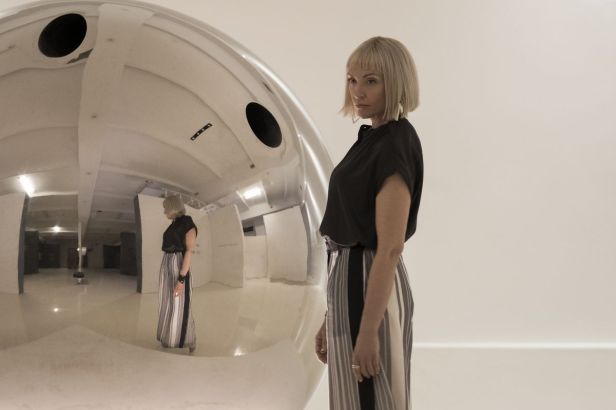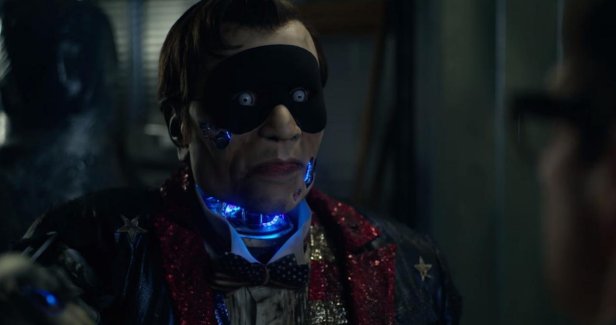Set in the inane, vacuous world of modern art, Dan Gilroy’s satirical supernatural slasher – made for and available through Netflix – boasts a great ensemble cast (not all of who are firing on all cylinders it should be said) attempts to shine a light on a self-absorbed, hermetically sealed milieu filled with vile, pretentious arseholes more obsessed with money, status and image than with the art itself. It doesn’t quite work but it’s an ambitious, sometimes witty and often inventive effort.
Josephina (Zawe Ashton) works for the venal gallery owner Rhodora Haze (Rene Russo) and has just started an affair with much-feared art critic Morf Vandewalt (Jake Gyllenhaal) when she finds an elderly neighbour, Vetril Dease, dead in the corridor of her apartment block. She investigates and finds that he was an undiscovered artist of considerable power and inventiveness, creator of dark, tormented works that come to obsess anyone she shows them to, including Morf, Rhodora, Morf’s assistant Gretchen (Toni Collette) and abstract artist Piers (John Malkovich). But Dease wanted the paintings destroyed after his death and soon enough anyone who attempts to capitalise on his work is meeting a sticky end.

It’s an intriguing idea but Velvet Buzzsaw (the title has little to do with the actual film – it’s the name of a punk band that Rhodora used to be in and her band logo tattoo features in one of the more memorable deaths) is wildly inconsistent and over long. It begins well enough with a collection of what are no doubt stereotypes (but at least they’re amusing stereotypes) sniping at each other, stabbing each other in the back and generally confirming any and all prejudices and fears you may have had about those involved in the art world. But it soon becomes clear that the Gilroy only had one decent idea (art can kill its viewer) and he finds it hard to sustain it across the film’s 113 minutes. The direction is often very inventive without being too “showy” and Velvet Buzzsaw is visually stunning throughout, as befits a film about the art world, but there are far too many longueurs and the only likable character, a young assistant to Rhodora and later Morf, Coco (Natalia Dyer from Netflix’s Stranger Things) gets too little to do. As a result it’s hard to really warm to the film.
Gilroy mainly avoids the usual traps of the slasher movie and at least makes an attempt to flesh out his characters – appalling though most of them are – before killing them off in a series of sometimes inventive deaths. One character is consumed by a room full of paintings, their body ravaged by a rainbow of colours as they disappear into the artwork. Another bleeds to death after having their arm torn off by an interactive art piece that looks and behaves like a gigantic version of the killer silver balls from Phantasm (1979). Elsewhere characters find themselves losing their grip on reality as they are assaulted by strange hallucinations caused by whatever supernatural forces lurk in Dease’s work. There’s a hint of John Carpenter’s masterly In the Mouth of Madness (1994) about Velvet Buzzsaw – in both films the work of a creative artist has a detrimental effect on those exposed to it.

What makes the sidelining of Dyer’s character particularly annoying, apart from the fact that she’s the only halfway “normal” character in the film, is that she seems to be the key to understanding Dease’s motivations. She’s an innocent in the whole affair, much abused by the people around, and never really seeming all that sure what she wants to do in this horrifying industry. She’s one of the few characters to not try to make money or win influence on the back of Dease’s work so is allowed to walk away, escaping the art world to return home to her family. Similarly, Malkovich’s artist makes it unscathed to the end credits by virtue of having escaped from the suffocating world of Rhodora, Morf and the rest early in the film – he gets out of the business and is last seen creating sand art on a beach, work that is meant to be destroyed and never seen by anyone else. Dease, it seems, is happy enough to let people go if they can demonstrate that they’ve learned something from their experiences and demonstrate the good sense to distance themselves from the people trying to exploit him. Retain your integrity and live is the central message of the film – sell out, reduce art to a commercial commodity (it’s referred to here at least once as “the product”) and die.
Velvet Buzzsaw is very much a mixed bag then. It’s not particularly scary and though some of the killings are inventive they needed to be nastier to really make an impact. Its ambition is to be applauded but Gilroy never really makes his mind up what he wants to the film to be. It might have played better without all the supernatural stuff, as a straightforward parody of a world so absurd that it’s almost a parody already. But the satire isn’t quite sharp enough, the horror isn’t scary enough and the great ensemble cast ill-served by the script. Gyllenhaal’s art critic – trapped in a failing gay relationship who finds temporary escape in an equally doomed relationship with Josephina – veers back and forth between pretentious buffoon, unintended comic relief and supposed audience identification figure. Zawe Ashton – usually so much better than this – sleepwalks through a nothing role and Toni Collette as the former assistant trying to set up as an agent in her own right is criminally under-used. Malkovich, Dyer and particularly Russo come off best.

After a promising start, Velvet Buzzsaw runs out of steam very quickly and needs a good trim to tighten things up. There’s a good idea buried in here somewhere but Gilroy doesn’t know what to do with it so tries a scatter-gun approach that just doesn’t work. It’s effective as neither a satire nor a horror film and, though it’s always beautiful to look at, its lack of focus and panoply of unlikable idiots make it harder work than it needs to be. A failure then, but one not without some interesting ideas that sadly aren’t always developed satisfactorily.